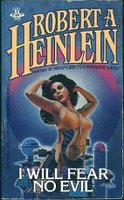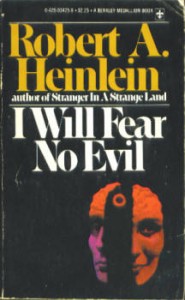 I Will Fear No Evil was Robert A. Heinlein ‘s 26th novel, published in 1970. At this point, the Grandmaster was 62 years old that year, and had four Hugo Awards for best novel to his credit. IWFNE is widely regarded by science fiction fans (and there are no higher authorities on everything) as the worst thing he ever published.
I Will Fear No Evil was Robert A. Heinlein ‘s 26th novel, published in 1970. At this point, the Grandmaster was 62 years old that year, and had four Hugo Awards for best novel to his credit. IWFNE is widely regarded by science fiction fans (and there are no higher authorities on everything) as the worst thing he ever published.
I love this book. I’ve read it a half dozen times since high school (as I’ve read all of RAH’s later novels repeatedly) and will probably read it a half dozen more if I live long enough.
But, before I tell you why I love it, let me heap a little more evidence on the other side of the scales, because I love a challenge. Heinlein was a pantser, not a plotter. That is to say, he wrote by the seat of his pants, without an outline. He also did not like to rewrite–although he did substantial re-writing on his most problematic and best-known work, Stranger in a Strange Land. He preferred to write and write and write, and then cut out the chaff.
My source for two of these pieces of information–the lack of outlines and the preference for cutting over re-writing–is not written. It is Dr. Beatrice Kondo, who knew Heinlein, and whose father, Dr. Yoji Kondo, was a frequent Heinlein correspondent for the last 15 or so years of RAH’s life. That “Stranger” was hard for RAH to write is corroborated in the wonderful Gifford biography of Heinlein. [Edit: I have no idea why I wrote ‘Gifford’ here. William H. Patterson, Jr. wrote the definitive Heinlein biography. J. Daniel Gifford wrote Robert A. Heinlein: A Reader’s Companion, which I have not read. SHW, 2025] And the other two stories are no doubt documented somewhere. I just don’t need documentation above and beyond what the Kondos furnished me over the years.
Heinlein wrote IWFNE between June and September, 1968. After completing the first draft, his Naval Academy class reunion and a hospitalization cut into his editing time. He felt the book was still too long when submitted, but his agent, Lurton Blassingame, found it intriguing and then found it a publisher. Heinlein once noted (I believe in one of his letters in Grumbles from the Grave) that at this point in his career, his contracts specified that an editor couldn’t even remove a comma from the middle of a word in one of his books without his written approval. In short, IWFNE went to press and on to the public without the polish that Heinlein gave most of his books, and Heinlein himself said, “That novel is about 30,000 words too long.”
So there, haters, if you’re gonna hate, Heinlein himself gave you fuel for your fires. Hope they keep you warm on those cold nights in Hatestown.
I maintain that I love this book, and don’t really care that it was, by its author’s own admission, something of a rough draft. I wish my rough drafts all read like this.
I Will Fear No Evil is the story of Johann Sebastian Smith, a very old, very rich man who is dying. He’s rich enough to do something about that, however, and what he does, through his lawyer, Jake Salomon, is arrange to have his brain transplanted into the body of the first available donor. As happens too often, a young, healthy body becomes available sooner rather than later. Someone is murdered, but, while the brain is damaged beyond repair, the body can be kept alive on life support until Smith’s brain is implanted. He doesn’t actually expect to survive the procedure. It’s a dodge to allow himself to die without actually committing suicide and gumming up his estate.
There are two gotchas awaiting Mr Smith: One, his new body is female. Two, it’s the body of his secretary, Eunice Branca, whom he adored. But the body is healthy as an ox, and horny as a goat, and Johann, now named Joan Eunice, starts over as an energetic woman in love with life. (I appreciated that RAH specified that “Joan” was pronounced “Jo-Ann.” My Grandmother’s name was the same in spelling and pronunciation. I doubt she was ever a rich old man. Ma was tricky, though, so I can’t say for sure.)
Many complications arise–legal ones, for instance. The operation itself is of dubious legality. Smith’s heirs also challenge Joan Eunice’s right to Smith’s estate in court. They think that their father should die like a dutiful parent and leave them his millions. It’s not fair for him to suddenly be younger than they are.
Then there’s the fact that Eunice apparently hasn’t moved out of her old body. As soon as Smith awakens, Eunice begins to speak to him in his head. Does this mean Heinlein was suggesting that the identity does not reside solely (or soul-ly) in the brain? He never takes a stand on this question. He builds a very convincing case that Johann’s brain has not actually survived the procedure, and is slowly descending into madness throughout the novel. Is this a story of madness? Of demonic possession? Of a gestalt being, which was a hot concept in the early 1970s? It’s never clear, but it’s a hell of a lot of fun trying to figure it out.
 The book takes hits by critics–as do many of Heinlein’s later works–for gratuitous sexuality. (Also, ironically, for not being graphic enough in its sex scenes.) Some find it offensive that Heinlein’s heroines are “always ready for sex.” I personally find it offensive that these critics think there are not women who are always ready for sex. Isn’t it a stereotype that only men like sex? I thought it was, anyway. Admittedly, IWFNE goes farther than most, especially in the only actual spanking scene that RAH ever wrote. The point of the sexuality, though, is that this character is loving life, and finally doing and enjoying the things that her previous life as an industrialist didn’t allow her to do. Nearly fifty years ago, Heinlein, like a true visionary, was predicting the liberation that was possible to someone who was freed of the bonds of gender stereotypes. Contrast this to modern SF writers, who would rather give us orders on what to believe about gender, or deliver long lists of things we’re not allowed to think, much less say.
The book takes hits by critics–as do many of Heinlein’s later works–for gratuitous sexuality. (Also, ironically, for not being graphic enough in its sex scenes.) Some find it offensive that Heinlein’s heroines are “always ready for sex.” I personally find it offensive that these critics think there are not women who are always ready for sex. Isn’t it a stereotype that only men like sex? I thought it was, anyway. Admittedly, IWFNE goes farther than most, especially in the only actual spanking scene that RAH ever wrote. The point of the sexuality, though, is that this character is loving life, and finally doing and enjoying the things that her previous life as an industrialist didn’t allow her to do. Nearly fifty years ago, Heinlein, like a true visionary, was predicting the liberation that was possible to someone who was freed of the bonds of gender stereotypes. Contrast this to modern SF writers, who would rather give us orders on what to believe about gender, or deliver long lists of things we’re not allowed to think, much less say.
Heinlein explored, and sometimes he got it wrong. He asked questions, though, that others were not brave enough to ask, and he shared his own thoughts about those questions, without first asking any committee to draft for him a treatise on what he was allowed to say.
Another criticism of the book, and one which I’ll admit made me uncomfortable the first time I read it at age 17, is the violent, decaying world which is depicted as turn of the (21st) Century North America. IWFNE is a novel set in a dystopia which doesn’t care that it’s set in a dystopia. It details the defects of the society portrayed without proposing remedies, and without showing any negative impacts of that society on the lead characters. (Well, Eunice does get murdered on the street, but, since she’s with us until the last page of the book, that hardly seems to slow her down.) The America portrayed here is stricken by poverty, horribly violent–you simply don’t go outside without armed guards and an armored vehicle–and horribly corrupt. The only people not affected by this are the very rich like Smith. They can buy their way out of hell.
As a young liberal, this really bothered me. Why, I wondered, did Smith and his brethren not spend all their money to change this? As an older ex-liberal, I realize that, in the real world, all your money can’t solve the world’s problems, but it can sometimes protect you from them. While it’s nice to help others, and I believe in doing so, Heinlein’s setting up a situation here where everyone’s in hell, and the only way out is to purchase favor. Would you stay in hell?
I wouldn’t. I have a family. Sorry.
And Joan Eunice does try to help those she can, like Eunice’s widower, Joe, whom she insists on visiting.
Finally, it’s a challenging book because you’re really not sure what the hell is happening at the end. As I noted, I’ve become convinced that most of the narrative merely chronicles the failure of Smith’s brain as Eunice’s body rejects the transplant. But what a beautiful madness she suffers as she dies. And, in the end, does she die? The story reads very much like Smith’s brain dies as Eunice’s body dies in childbirth. And yet, at the end, Smith and Eunice are still there, with the suggestion that they’re possibly sharing the brain of their newborn child.
It’s not everybody’s cup of tea, but I’ll take it over any book that proclaims itself to be “Number X in the Chronicles of the Engineered World of the Glamorous Hula People of Newlandia.”


Good review. Did exactly what a positive review should do: inspired me to read the book. Kudos.
I read this book back ca 1978. In my long term recall of events, Joe,Eunice’s husband when she is alive and still a secretary of the “ancient” and long sufferring Smith, as a so called talented individual-a visual artist with great skill and abilities. Eunice cares for his with depth unlike anything between the Later Joe-Ann and Lawyer Salomaon-a weall to do, older but strictly conservative Jewish lawyer who refuses to allow any smith-like corners of is life to be cut. No one ever mentions who Joe Ann’s impregnated infant is-it is implied-but without the good, kind and generous but unable to read man who was her legal and formal husband on Earth, none of the events subsequent would have been possible.
The biggest drawback of Eunice’s artist hubby was his inability to read-a common problem in late 20 and 21st century America-the problem of a an undercls of people who might fix your car, paint a da inci’esque masterpiece but cannot read!
in ALL-AND I INCLUDE HIS CONDEMNED post NUCLEAR WAR, TIME BENDER -THE PEOPLE AROUND THE LONg LIVED WHITE PROTAGONIST, TEND TO BE THE ONES WITH THE REAL POWER-AND WHO, TO MAKE HIS DREAMS POSSIBLE, (BECAUSE THEY ARE BASICALLY GOOD-IF PRODUCTS OF THEIR Own cultures-.
The ordinary people make Heinlein’s stories possible-even in their most difficult moments of time travel , which give Heinlein’s character’s, (like Howard or SMith and many others before and after), getting a second or third(maybe an infinite?- number of extra shots which the rest of us are prevented from even considering.
Read Philip Jose Farmer’s books in the “Beyond the Blue event horizon” series,(and other books including the riverboat series), about a guy tripping and breaking his legs or bumping his head until he manages in the increasingly ruined and ruinous earth to discover-almost accidentially, that we are all in a left over reality-and that he is being given a shot at retrieving the existence of billions of sentient individuals, almost all are hiding behind the “event horizon’s ” of black holes, so they are not subject to time’s passage, but will not be killed and have their cultures’ ruined by whatever seems to be undoing the intelligent species of the nearby star systems.
The idea of eternal life-either physical or in computers or from gravity near black holes, is a big and attractive subject, it seems in all science fiction-and everyone wants the opportunity to “try it again”.
Um, you’re conflating two series there. Philip Jose Farmer did, in fact, do the Riverworld series, which does involve using the Suicide Express to travel along the River.
However, “Beyond The Blue Event Horizon” is part of the Heechee saga, by Frederick Pohl, and the billions of souls hiding behind the event horizon of a black hole are those of the Heechee.
Not to pick a nit, but Glory Road also has a spanking scene eh Oscar spanks Star hard enough to leave handprints. But he says after something like ten smacks, he gets bored and flips her over to have sex with her. There is no indication that she enjoyed this, unlike Joan Eunice who has her “first female orgasm” during the spanking.
I remember that scene in GR, yes. I think when I wrote this ( assuming I thought when I wrote this!) that I didn’t consider that a “full” scene because Oscar got distracted.